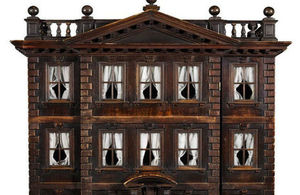Rare early Georgian baby house at risk of leaving the UK
Arts minister steps in to prevent miniature house from export.

A rare early Georgian baby house.
Arts Minister Michael Ellis has placed a temporary export bar on a rare Georgian baby house to provide an opportunity to keep it in the country.
The baby house (later known as a dolls’ house) is at risk of being exported from the UK unless a buyer can be found to match the asking price of £65,000 (plus £13,000 VAT).
The house is a rare and magnificent example from the early 18th century, one of only around thirty surviving examples of pre-1760 English baby houses. It descended through the family of William Edward Forster, the Liberal MP who introduced the Education Act of 1870 and was later Chief Secretary for Ireland.
Jesse Burton’s best-selling 2014 book “The Miniaturist” brought baby houses to renewed attention in recent years. The book was inspired by Petronella Oortman’s famed baby house, on display at Amsterdam’s Rijksmuseum. It was also made into a two-part BBC series, which aired over Christmas last year.
The concept of the miniature house came to England from the Netherlands and Germany in the early 18th century, and was intended for training the young daughters of wealthy families in household management. Miniature furniture, and utensils in silver, pewter and porcelain, were supplied by toy merchants, while girls were encouraged to develop sewing skills by making clothes for the house’s dolls.
Due to their intricate and expensive design baby houses were more a training tool than a plaything for children until the early 19th century, when the design was simplified and production increased, resulting in the dolls’ houses of more recent times.
Arts Minister Michael Ellis said:
This striking piece is a captivating window into the history of childhood. I hope it can remain in the UK, where it can be studied and admired further.
The decision to defer the export licence follows a recommendation by the Reviewing Committee on the Export of Works of Art and Objects of Cultural Interest (RCEWA), administered by The Arts Council.
RCEWA member Peter Barber said:
This captivating and little altered house in miniature takes us into the elegant eighteenth century home while also shedding unique light on the education of young middle class girls at that time.
The RCEWA made its recommendation on the grounds of the house’s outstanding significance for the study of the history and material culture of childhood.
The decision on the export licence application for the house will be deferred until 1 May. This may be extended until 1 August if a serious intention to raise funds to purchase it is made at the recommended price of £65,000 (plus £13,000 VAT).
Organisations or individuals interested in purchasing the house should contact the RCEWA on 0845 300 6200.
An image of the house can be downloaded via our flickr site.
ENDS
For media information contact: Yasmin Kaye, Senior Communications Officer, Department for Digital, Culture, Media and Sport Tel: 0207 211 6489 Email: [email protected]
Notes to editors
- Details of the house are as follows: Probably made between 1720 and 1740. Largely made of mahogany, oak and softwood, and with glazed windows, measuring 204cm high, 135cm wide, and 67cm deep. The maker and early provenance are not known. The piece is in good condition, with numerous small areas of damage and historic repairs, but with minimal losses.
- Provenance: Possibly with Elizabeth and Sarah Forster at Grove House, Tottenham and thence by descent to; William Edward Forster and thence by descent to; Florence Vere O’Brien and thence by descent to; Elinor Wiltshire; sold to Christopher Gibbs Ltd; acquired by a private collection; Sold at Bonhams, London, 19 November 2009, lot 37 (£43,000 inc. prem.); sold at Sotheby’s, London, 23 May 2017, lot 200, The Ballyedmond Collection Sale (37,500 inc. prem)
- The Reviewing Committee on the Export of Works of Art and Objects of Cultural Interest is an independent body, serviced by The Arts Council, which advises the Secretary of State for Digital, Culture, Media and Sport on whether a cultural object, intended for export, is of national importance under specified criteria.
- The Arts Council champions, develops and invests in artistic and cultural experiences that enrich people’s lives. It supports a range of activities across the arts, museums and libraries – from theatre to digital art, reading to dance, music to literature, and crafts to collections. www.artscouncil.org.uk